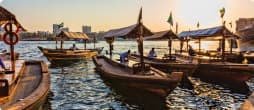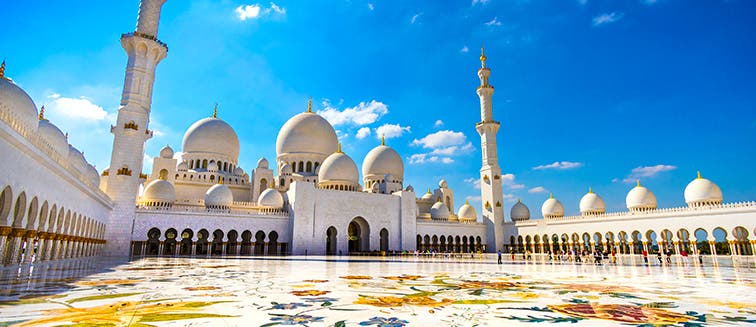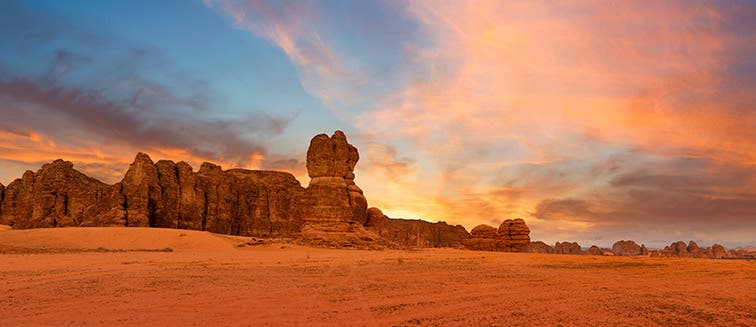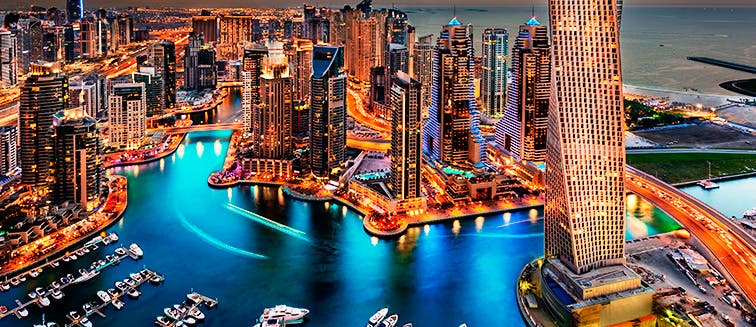One destination in particular instantly springs to mind at the mention of the United Arab Emirates: Dubai, the glittering metropolis which sprung from the desert sands and today reaches high into the clouds and out into the gulf on magnificent man-made islands. To the average traveler, United Arab Emirates means glitzy shopping malls, luxury resorts, endless leisure attractions and unfathomable wealth, but there are seven Emirates in total and Dubai is, although glorious, only the tip of the iceberg.
Abu Dubai, Ajman, Fujairah, Ras Al Khaimah, Sharjah, and Umm Al Quwain are the other Emirate Sheikhdoms, each with their own distinct traits. Ras Al Khaimah is a popular beach haven, known for its watersports and adventurous mountain trails, whilst Sharjah is a center of Emirati art and culture, home to archaeological sites and a number of museums. The capital, Abu Dhabi is constantly looking towards the future whilst the drifting sands of the Empty Quater remain unchanged by the hands of time. Due to the international airport hub, Dubai is many travelers' first taste of travel to the Middle East and most who travel to the United Arab Emirates find there is a real east-meets-west atmosphere.
Many elements of cultural and religious life are different from the West, but at the same time, you can find all the usual western chains and the pull of consumerism is ever-present. If you travel to the United Arab Emirates you’ll have a rich array of experiences on offer in an easily accessible area. Go shopping at the world's largest mall in Dubai and look towards the sky in awe at the gravity-defying Burj Khalifa before exploring mountain top forts in Ras al Khaimah and visiting the vast marble-clad Sheikh Zayed Grand Mosque in Abu Dhabi, a true architectural wonder.
History of the United Arab Emirates
The United Arab Emirates did not come into existence until 1971. Before this time the Emirates was known as the Trucial States. This region of the Arabian Peninsula has a long, fascinating history, having been well-known to the Sumerians for their abundant and valuable resources and trade, thanks to its strategic coastal position, attracting merchants from as far away as India and China. Bronze-age tombs and ruins in Al Ain reveal this long history and are a must-see on a package holiday to the United Arab Emirates.
The region became Islamicized in the 7th-century, whilst permanent settlements of fishermen and traders along the coast coexisted with the Bedouin communities of the deserted interior. Due to the Emirates' valuable location and resources, there was a proliferation of conflicts in the region from the 16th-century onwards, particularly between the European powers of Portugal, France, and the British, who vyed for control over the region. The Portuguese had the most profound effect on the Arabian peninsula, colonizing it for much of the 16th-century, attracted by the precious pearl reserves along the coast.
The British expelled the Portuguese in 1625 and over the next few centuries, a number of treaties were signed between the British and the leaders of the Trucial States, resulting in peace and prosperity along the Arabian coast and an influx of trade. In 1971 the British withdrew from all involvements with the Emirates, leading to the establishment of the United Arab Emirates, founded on the agreement of the Sheikhs of each state. If you travel to the United Arab Emirates today, you’ll notice the impressive riches and amazing architecture of cities such as Dubai, where towering skyscrapers have sprung from the desert in the last half-century following the discovery of oil in 1966.
Nature in the United Arab Emirates
Concrete jungles with glistening skyscrapers are the images that spring to mind when you think of the United Arab Emirates, but there are actually many pockets of beautiful and untouched natural landscapes to explore on a trip to the United Arab Emirates. Mythical deserts, palm-fringed oases, and rugged mountains can be found throughout the diverse Emirate states. Each of the Emirates has, to some extent, its own desert areas, the perfect places to get in touch with Bedouin culture.
The Empty Quarters stretch from Abu Dhabi to Saudi Arabia and into Oman and is one of the most iconic deserts in the region, home to a number of different desert tribes. Fossilized creatures and meteorites have been found in this desolate region, and for the most adventurous travelers, traversing these dusty plains is a must-do on a tour of the United Arab Emirates. A number of nature reserves protect the most idyllic parts of the country’s natural environment. The Dubai Desert Conservation Reserve is one of the most popular and visited reserves in the United Arab Emirates and is a haven for birds, free-roaming oryx, and desert wildlife. Dune safaris, trekking, and even sand-boarding are just a few of the ways travelers on a trip to Dubai can experience this rich, orange-hued landscape.
In the Emirate of Sharjah, a little known gem, you can discover the wetlands of Khor Kalba, an expansive green space home to a unique birdlife. A rare sight in such a harsh climate, these wetlands are a must-visit if you travel to Sharjah. The Hajar Mountains, which stretch across the eastern United Arab Emirates, is the perfect destination for those looking to explore off the beaten track. Hiking trails, caves, and historic forts are scattered throughout this rugged landscapes, so there’s plenty to uncover as well as enjoying the spectacular views. Finally, the United Arab Emirates boasts a beautiful coastline on the Persian Gulf and the Gulf of Oman, so beach-lovers are spoilt for choice with more than 1,300 kilometers of sand and sea to explore.
Culture in the United Arab Emirates
As an Islamic country, religion plays a vital element in the lives and culture of Emiratis. The weekend begins on Friday, as it is the holiest day of the week, and visitors on a trip to the United Arab Emirates will hear the five-times-daily call to prayer which sets the pace for day-to-day life in the United Arab Emirates. Traditional, modest clothing is widely worn amongst both Emirati men and women and is an important part of the culture. Many elements of Emirati culture are very different from what we expect in the west; gender roles, class systems and family life are all governed by religious traditions as the United Arab Emirates’s judicial system is based on Sharia law.
Arabic is the official language, although you’ll find that English is widely spoken and understood, particularly in Dubai and Abu Dhabi. Amongst the glitz and glamour of the United Arab Emirates’s gravity-defying cityscapes, elements of traditional Arabic culture still exist if you know where to look for them. Sharjah has a great number of heritage sites where you can step back in time. Alternatively, a desert excursion to an authentic Bedouin camp is a popular activity for travelers on a tour of the United Arab Emirates who want to see the age-old traditions of these indigenous communities. Dubai’s Old Town is another must-visit for those interesting in knowing more about the culture of the United Arab Emirates. Here, visitors can cross Dubai Creek on a traditional abra boat, shop for bargains in the glittering gold souks and dine on delicious Arabic food for a fraction of the price found elsewhere in the city.
The United Arab Emirates is so much more than the post-card metropolis of Dubai or the skyscrapers of Abu Dhabi, but they’re still a great place to start. After you’ve had your fill of shopping, sightseeing and beach lounging, the United Arab Emirates has a wealth of fascinating places to explore. Discover Ras Al Khaimah’s wonderful rugged coastline and enchanting mountains, Sharjah’s elegant heritage sites, and Al Ain’s historic ruins before spending a magical night in the desert at a Bedouin camp. Complex, beautiful and bursting with opportunities to get in touch with traditional Arabic culture, travel to the United Arab Emirates and discover it all.





















